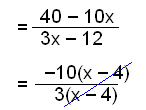| © 2006 Rasmus ehf og Jóhann Ísak Pétursson |
|
|
Lesson 2
Let’s look at more complicated examples.
|
Example
1
|
|
|
|
We can multiply both the numerator and denominator by -1 without changing the fraction. |
|
|
If we multiply the the
denominator by -1 it will be the same expression as the numerator. We
leave the -1 in the numerator outside the bracket and cancel .
|
We can summarise the results of the above
example by the simple rule:
 |
This rule applies if we have a fraction
where the numerator and the denominator are the same except that all the terms
in the numerator have the opposite sign to the terms in the denominator . |
| Example 2 | |
|
|
We add together the terms in the numerator by finding the common
denominator. We do the same with the denominator. |
|
|
Now we can change the division into a multiplication as before and put the
two fractions together over one dividing line. Finally we can factorise and
cancel out the common factors |
| Example 3 | |
|
|
Again we add together the terms in the numerator and the denominator. |
|
|
Next put the two fractions together over one dividing line. Then we simplify, factorise and cancel out the common factors.
|
|
|
Note: −5(x − 4) = 20 − 5x. |
Sometimes it’s simpler to multiply the numerator and the denominator with the commom denominator of all the fractions.
| Example 4 | |
 |
The common denomiator of all the fractions in this example is 12. |
 |
|
 |
Finally we factorise and cancel as much as possible. |
 |
Try Quiz 2 on Fractions dividing fractions. Remember to use your Checklist.